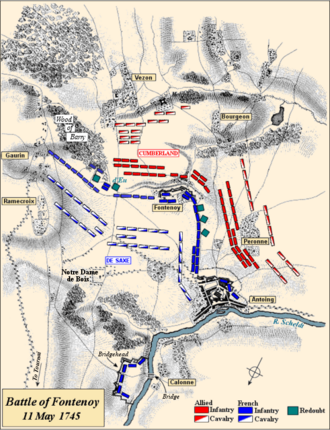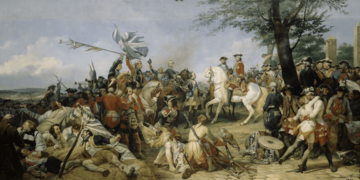Battle of Fontenoy facts for kids
Quick facts for kids Battle of Fontenoy |
|||||||
|---|---|---|---|---|---|---|---|
| Part of the War of the Austrian Succession | |||||||
 The Battle of Fontenoy by Pierre L'Enfant |
|||||||
|
|||||||
| Belligerents | |||||||
| Commanders and leaders | |||||||
|
|
||||||
| Strength | |||||||
| c. 50,000 men 100–110 guns |
c. 50,000 men 80-101 guns ; |
||||||
| Casualties and losses | |||||||
| c. 8,000 killed or wounded | c. 12,000 killed, wounded, or captured, plus 40 guns lost | ||||||
The Battle of Fontenoy was a major battle fought on May 11, 1745. It took place near a town called Tournai, which is now in Belgium. This battle was part of a bigger conflict known as the War of the Austrian Succession.
In this battle, a French army of about 50,000 soldiers, led by Marshal Saxe, faced off against a similar-sized army. This opposing army was made up of soldiers from Britain, the Netherlands, Hanover, and Austria. It was led by the Duke of Cumberland.
The French army won the battle. This victory helped France take control of the Austrian Netherlands. However, the war did not end right away. Peace talks continued for several years.
Contents
Why the Battle Happened
The War of the Austrian Succession started in 1740. This was because the Holy Roman Emperor, Charles VI, died without a male heir. His daughter, Maria Theresa, was supposed to take over. But some countries did not agree with a woman ruling.
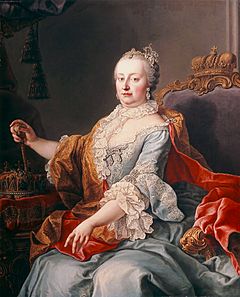
Charles of Bavaria claimed the throne instead. This led to a big fight across Europe. France, Prussia, and Saxony supported Charles. Britain, Austria, Hanover, and the Dutch Republic supported Maria Theresa.
By 1745, France was running out of money. They hoped a big win in the Austrian Netherlands would end the war. Marshal Saxe decided to attack Tournai. This was an important town that controlled a major river, the Scheldt.
Saxe believed that attacking Tournai would force the Allied army to come and fight. He left some troops to continue the siege of Tournai. Then, he set up his main army about 8 kilometers (5 miles) away. He chose a strong defensive position near the villages of Antoing, Vezon, and Fontenoy.
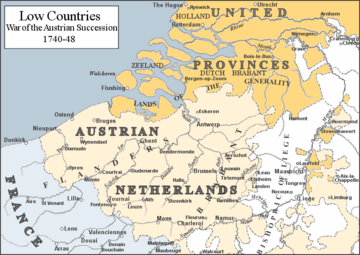
Planning the Attack
The Allied army was led by the 24-year-old Duke of Cumberland. He was advised by an experienced general, Earl Ligonier. The Allied army included British, Hanoverian, Dutch, and a few Austrian soldiers.
However, the Allied leaders often disagreed. The British and Hanoverians did not trust each other. Austria did not see this area as a top priority. The Dutch commander, Prince Waldeck, was also not popular with his officers. Cumberland was young and sometimes ignored advice. These problems made it hard for the Allies to work together.
The French army started besieging Tournai on April 28. The Allies marched to help the town. On May 7, Marshal Saxe moved his main army of 50,000 men to a strong defensive line. This line was set up around Fontenoy and Antoing.
The Battle Begins
Marshal Saxe knew his infantry (foot soldiers) were not as good as the Allies'. So, he placed them behind strong defenses. He also fortified the villages. The French line was on top of a hill. Their right side was protected by the Scheldt River. Their left side was behind a wood called Bois de Barry. Two forts, Redoubt d'Eu and Redoubt de Chambonas, covered the space between the wood and the village of Fontenoy.
The Allies first saw the French on the evening of May 9. Cumberland and his officers quickly checked the area. But they missed seeing the Redoubt d'Eu. On May 10, British and Hanoverian cavalry (horse soldiers) pushed the French out of some small villages.
An Allied officer suggested sending infantry into the Bois de Barry. This would allow the cavalry to go around the French left side. But this plan was stopped when Dutch soldiers were shot at from the wood.
The main attack was delayed until May 11. At 4:00 AM, the Allied army got ready. The British and Hanoverians were on the right and in the middle. The Dutch were on the left. The Austrians were held back as a reserve.
The Dutch were ordered to attack Fontenoy and Antoing. Another group was to capture the Redoubt de Chambonas and clear the Bois de Barry. Once these side attacks were happening, the main Allied infantry in the center would push forward. They would attack the main French army.
Fighting at Fontenoy
The Allied cannons started firing at Fontenoy as soon as it was light. But the French soldiers were dug in, so the cannons did little damage. Cumberland had underestimated how many French soldiers there were. He thought the main French force was in the middle. He did not realize how strong the French defenses were on the sides.
The strength of the French left side became clear when the British commander, Richard Ingoldsby, ran into the Redoubt d'Eu. He asked for cannon support. His advance stopped as his men fought with French light troops. Ingoldsby was unsure of the French strength and hesitated. This delay slowed down the main Allied attack.
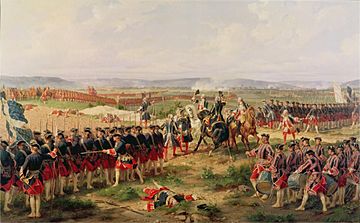
Cumberland grew impatient. At 7:00 AM, he told Ingoldsby to stop attacking the Redoubt d'Eu and join the main column. But he forgot to tell Ligonier about this change. As the Dutch attacked Fontenoy, they were hit by heavy fire from a nearby cemetery. They had to fall back with many losses.
At 10:30 AM, the Dutch attacked Fontenoy again. They had some success at first. But they were forced to retreat again. At 12:30 PM, Cumberland ordered the main central column to advance.
About 15,000 Allied infantry soldiers, led by Cumberland and Ligonier, marched up the hill. They suffered many losses but kept their formation. They stopped to straighten their lines. Then, the British Guards in the front line supposedly invited the French Guards to fire first. This story might not be completely true. But in battles, commanders sometimes wanted the enemy to fire first. This was especially true if their own troops were well-trained and could handle the first volley without breaking apart.
The French Guards fired too early, which made their first volley less effective. The British volley, however, killed or wounded 700 to 800 French soldiers. The French front line broke apart. Many of their reserve troops had been moved to fight the Dutch at Fontenoy. The Allies pushed into this gap.
King Louis XV was watching the battle. His advisors urged him to leave for safety. But Marshal Saxe told the King that the battle was not lost. French cavalry then launched several attacks, pushing the Allies back.
Cumberland was in the middle of his column and had lost control of the overall battle. He did not order new attacks on Fontenoy or the Redoubt d'Eu. The Allied column was being fired on from both sides and the front. They formed a hollow square, which reduced their own firing power.
The French cavalry attacks gave the French infantry time to regroup. At 2:00 PM, Saxe brought up his remaining cannons. They fired into the Allied square from close range. Then, the French launched a full attack. Many French regiments attacked from different sides. The Irish Brigade, fighting for France, lost many soldiers, including 25% of their officers.
Marshal Saxe and other French commanders led the final attacks. Elite French cavalry also joined in. The Allied column was forced back with heavy losses. Despite this, the Allied infantry kept their discipline. They retreated in an orderly way, stopping to fire at their pursuers. When they reached Vezon, their cavalry covered them as they marched away. They retreated 180 kilometers (110 miles) to Ath, mostly undisturbed by the French.
The Dutch officers did not want to retreat. They did not want to abandon their soldiers in Tournai. One officer wrote that they were pushed back but not defeated. But their quick retreat made them look beaten. They left behind much equipment and many wounded soldiers. The next day, French cavalry captured 2,000 wounded Allied soldiers and 44 abandoned cannons.
After the Battle

Fontenoy was a very bloody battle. The French lost about 7,000 to 8,000 soldiers killed or wounded. The Allies lost between 7,400 and 12,000 soldiers, including prisoners. This victory made France a leading military power in Europe again.
King Louis XV was the first French king to win a battle against the English since Saint Louis. This was used in French propaganda. The writer Voltaire even wrote a poem about the battle.
Marshal Saxe's reputation grew as a great general. He was in great pain during the battle from a disease called dropsy. He had to be carried around the battlefield in a chair. But his leadership was key to the French victory.
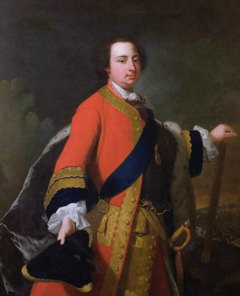
On the other hand, Cumberland did not perform well as a commander. He ignored advice from his more experienced officers. He failed to make sure the Bois de Barry was properly cleared. He also gave confusing orders. He was brave, but his involvement in the infantry attack meant he lost sight of the bigger picture.
After the battle, Richard Ingoldsby was put on trial for delaying his attack. He claimed he received confusing orders, which was true. He was forced out of the army, which many thought was unfair. Cumberland and his staff also blamed the Dutch for not helping the center. But the Dutch infantry retreated in good order.
The Dutch commanders were critical of their own troops' lack of initiative. This led to a big retraining program for the Dutch army. They performed much better in later battles. However, the war showed that the Dutch Republic was no longer a major world power.
Tournai surrendered on June 20. Other towns also fell to the French. In October, the British had to send troops home to deal with a rebellion. This allowed Saxe to continue his advance in 1746.
France did not declare war on the Dutch Republic until 1747. This made France's money problems even worse. French merchants had been using "neutral" Dutch ships to avoid the British navy. By the end of 1747, France had taken most of the Austrian Netherlands. But their economy was suffering badly. There were also widespread food shortages.
Peace was urgently needed. In 1748, the Treaty of Aix-la-Chapelle ended the war. Louis XV agreed to give up all his gains in the Austrian Netherlands for very little in return. This led to a French saying, "as stupid as the Peace."
Battle's Lasting Impact
The Irish Brigade fought bravely for France at Fontenoy. Because of their actions, Irish nationalists in the 1800s and early 1900s saw Fontenoy as a symbol of Irish military courage. Many streets and clubs were named after the battle. In 1905, a memorial to the Irish Brigade was built in Fontenoy village.
After the battle, King Louis XV reportedly said: "See how much blood a triumph costs. The blood of our enemies is still the blood of men. The true glory is to save it." This quote is on a memorial in the nearby town of Vezon.


